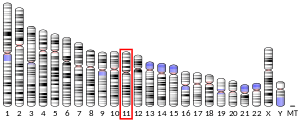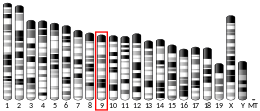SORL1
Sortilin-related receptor, L(DLR class) A repeats containing is a protein that in humans is encoded by the SORL1 gene.[5]
SORL1 (also known as SORLA, SORLA1, or LR11) is a neuronal apolipoprotein E receptor, the gene for which is predominantly expressed in the central nervous system.[6]
Clinical significance
Mutation of the gene for apolipoprotein E (APOE) is predictive of Alzheimer's disease.[7] Lack of the APOE receptor is suspected to be a contributory factor to Alzheimer's: a significant reduction in SORL1 (LR11) expression has been found in brain tissue of Alzheimer's disease patients.[8] The APOE receptor has also been linked with regulation of amyloid precursor protein, faulty processing of which is implicated in Alzheimer's.[9] A more recent study by a group of international researchers [10] supports the proposition that SORL1 plays a part in seniors developing Alzheimer's disease, the findings being significant across racial and ethnic strata.[11]
See also
References
- GRCh38: Ensembl release 89: ENSG00000137642 - Ensembl, May 2017
- GRCm38: Ensembl release 89: ENSMUSG00000049313 - Ensembl, May 2017
- "Human PubMed Reference:". National Center for Biotechnology Information, U.S. National Library of Medicine.
- "Mouse PubMed Reference:". National Center for Biotechnology Information, U.S. National Library of Medicine.
- "Entrez Gene: Sortilin-related receptor, L(DLR class) A repeats containing".
- "SORL1 sortilin-related receptor, L(DLR class) A repeats-containing [ Homo sapiens ]". Entrez Gene. United States National Center for Biotechnology Information. 10 January 2007. Retrieved 2007-01-15.
- Wade, Nicholas (15 January 2007). "Study Detects a Gene Linked to Alzheimer's". The New York Times. Retrieved 2007-01-15.
- Scherzer CR, Offe K, Gearing M, Rees HD, Fang G, Heilman CJ, Schaller C, Bujo H, Levey AI, Lah JJ (Aug 2004). "Loss of apolipoprotein E receptor LR11 in Alzheimer disease". Archives of Neurology. 61 (8): 1200–5. doi:10.1001/archneur.61.8.1200. PMID 15313836.
- Andersen OM, Reiche J, Schmidt V, Gotthardt M, Spoelgen R, Behlke J, von Arnim CA, Breiderhoff T, Jansen P, Wu X, Bales KR, Cappai R, Masters CL, Gliemann J, Mufson EJ, Hyman BT, Paul SM, Nykjaer A, Willnow TE (Sep 2005). "Neuronal sorting protein-related receptor sorLA/LR11 regulates processing of the amyloid precursor protein". Proceedings of the National Academy of Sciences of the United States of America. 102 (38): 13461–6. doi:10.1073/pnas.0503689102. PMC 1224625. PMID 16174740.
- Rogaeva E, Meng Y, Lee JH, Gu Y, Kawarai T, Zou F, Katayama T, Baldwin CT, Cheng R, Hasegawa H, Chen F, Shibata N, Lunetta KL, Pardossi-Piquard R, Bohm C, Wakutani Y, Cupples LA, Cuenco KT, Green RC, Pinessi L, Rainero I, Sorbi S, Bruni A, Duara R, Friedland RP, Inzelberg R, Hampe W, Bujo H, Song YQ, Andersen OM, Willnow TE, Graff-Radford N, Petersen RC, Dickson D, Der SD, Fraser PE, Schmitt-Ulms G, Younkin S, Mayeux R, Farrer LA, St George-Hyslop P (Feb 2007). "The neuronal sortilin-related receptor SORL1 is genetically associated with Alzheimer disease". Nature Genetics. 39 (2): 168–77. doi:10.1038/ng1943. PMC 2657343. PMID 17220890. Advance online publication; Volume/Issue/Page available later
- Hall J (15 January 2007). "Canadian-led team links gene to Alzheimer's". Toronto Star. Retrieved 2007-01-15.
External links
- SORL1 references from NCBI.
- "Study Detects a Gene Linked to Alzheimer’s". N. Wade, New York Times, Jan. 15, 2007.



